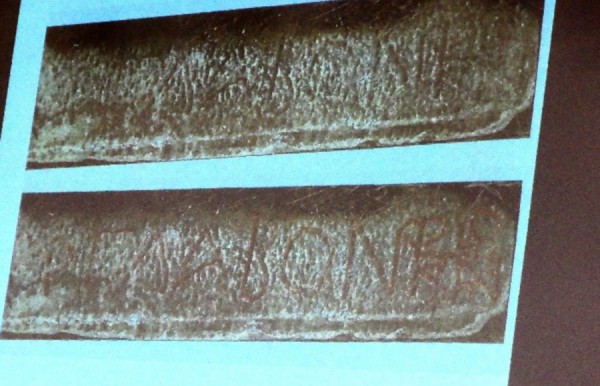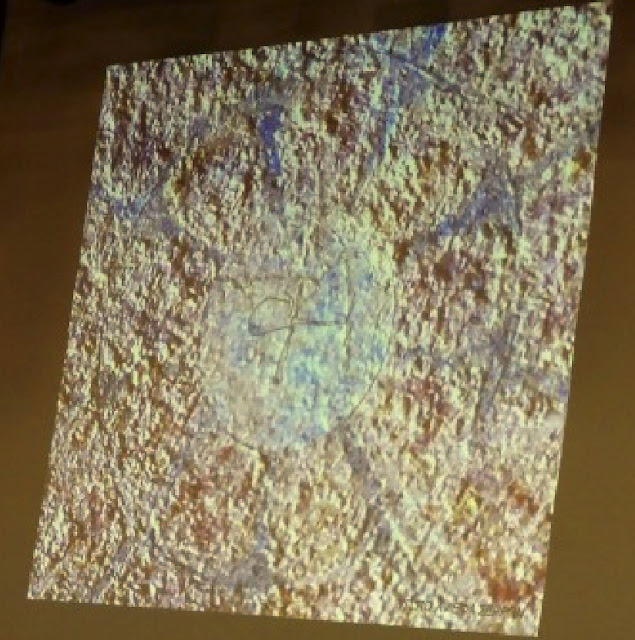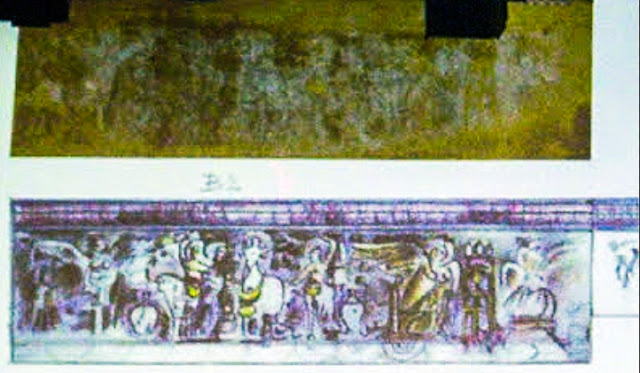Let's not stay in words archaeologists haven't even visited the Hill Kasta…..
Intense questioning about the chronological period and whether it is indeed new details of inscriptions on marble funerary monument yard on the hill which Kasta presented in scientific speech / presentation of the responsible archaeologist, Katerina Peristeri but and part research group, on Wednesday night at the Aristotle University, Express Classic Archaeologists, but the Assistant Professor of prehistoric archaeology and Osteoarchaiologias, in the Department of history and Archaeology at the Aristotle University of Thessaloniki, Sevi Triantaphyllou.
Most speak of fuzzy information, arbitrary archaeological approaches that may not refer to the Hellenistic period, but for inscription in marble of the grave yard, which is located 2 km. away from the Tomb, which should not be confused with the occupant or with what “Secrets” hides the grandiose Tomb.
“Discard the theories on Ifaistiwna”, answered unequivocally in what became known on Wednesday afternoon, Professor of Classical Archaeology at the Aristotle University of Thessaloniki and the who on 36 years he served on excavations at Vergina, Panos Faklaris. “Still looking to find out what the news”, fills the head of the Panel of bone found within the Tomb, Sevi Triantaphyllou.
What answers yet from the side of, the responsible architect Michalis Lefantzis Memorial;
What the new discoveries that turned again the interest of the scientific community in Amphipolis which “We had forgotten”;
Recent discoveries relate mainly to clarify the time era in which reportedly owns the great archaeological discovery of the tomb and which, like clarifies
in the NEWS 247 the responsible architect Michalis Lefantzis Memorial at Restoration ancient monuments in Athens, is undoubtedly the Hellenistic era and not the Roman.
“The important thing is that. That the monument is not Roman, as initially rushed many archaeologists to identify prior months. The opportunity to come to this conclusion is the inscription found in the grounds of the Tomb, in marble pieces and now undoubtedly, refer to the 4th century BC. X. and the Antigonid dynasty. This is certainly one of the many funerary war memorials of Ifaistiwna, as there are many more throughout the country, especially in Macedonia, Alexandria and Cheronia”.
The great discoveries (particular architectural type) they are known to excavators here and a few months, reveal that the tomb of Amphipolis was built by the Deinokrati or the Stisikrati after ordering and financing of Alexander the great, for his friend and trusted Officer, Ifaistiwna, After his death, While implemented by Antigonos the One-eyed, the first quarter of the 4th BC. century.
At the same time, the research team reported in Monogram – seal of the Macedonian Officer. The inscription “PARELABON IFAISTIWNOS” found in at least two building slabs, While in another marble fragment is the inscription “ANT”.
As ANT, According to the new cases, they signed all members of the Antigonid dynasty. The inscription is perhaps the “building a written contract” on receipt of the marble material destined for the ambitious project, probably Memorial.
“For many years the architectural parts was in public view, next to the lion.
But no one noticed the unnoticeable inscription on marble surface”, reported by Mr. Lefantzis and continued: “The word Parelabon is written in such a way, so that the-a and-a reference to Hellenistic era. If referred for example, in the era of Perseus, the letters would be different, According to the basic principles of epigraphy”.
As far as the lion lying in 2 km away from the tomb of the mound, This dates back to the 1936 e.g.. and “similar we can meet and Leo in Ekbatana, the area that the trusty Officer of Alexander the great, Hephaestion died 325 e.g.. So for this reason, actually, from the very first moment the belief that we will be confronted with finds from the Hellenistic period.
The lion like all marble pieces to close the Tomb, they moved there. And were a harbinger for the dead or dead and the significance of archaeological discovery. Were not there than ever. Dating and documenting findings both inside the Tomb (Sphinxes, Caryatids, mosaic floor) they resemble works of the same period kept in museums within and outside the country, as the monogram of Alexander in the second Chamber, but the oktafylloi relief rosettes”.
During the presentation of Ms. Peristeri, was also known to the tumulus has undergone numerous looting until the time of the last Macedonian, While stressed the existence of a cult space within Memorial. Also, revealed that coins were found burnt or damaged, which probably belong to the Mega or Alexander cassander.
When Mr. Lefantzi, like Mrs Peristeri, There is no longer any room for questioning that the monument of Amphipolis is the Hellenistic era. “Let's wait well those reacting”, says Mr. Lefantzis and ends:”Was a first scientific communication, I don't know when we'll have photos and documents, or when you know more info. Let's wait for the archaeological fermentation and let's not stay in words archaeologists haven't even visited the Hill Kasta”.
THE M. Lefantzis said us going for three identical inscriptions, While in her speech, Ms. Peristeri spoke of two identical and one third for which yielded no evidence, letting semicolon.
The word "…ARELABON "-missing" p "- and at the end of "n" is the monogram of Ifaistiwna. It is wrong what was written that the inscription says "PARELABAN IFAISTIWNOS" IRWON. The word "IRWON» no. THE M. Lefantzis explained that "distinguished very clearly in the, f, z, the CENTURY. Because it is large in size, we consider refers to Memorial». In her speech, Ms. Peristeri stated that ' this was a contract receipt "and the inscription is interpreted as" parelabon of Ifaistionos "heroon.
Wanting to strengthen this assessment, He did mention the "Parallel Lives" of Plutarch, stating that "when Alexander missed Ifaistiwna, asked by Deinokrati (Stisikrati) to erect brilliant war memorials throughout ". "It may have been 5-6 or even more. We don't know how many, but certainly it was two in Alexandria, and one in Ekbatana, where Hephaestion died. For we do not have a mention of Amphipolis in the Secretariat ", He m. Lefantzis.
The approximately 500 ' orphan ' architectural elements were transferred and located around the lion of Amphipolis by the 1937 When and restored the monument.
The second key element is the monogram of Ifaistiwna, They also found inside, in rosettes from the epistyle of the second area. MS. Peristeri spoke a enniafyllo rosette with Monogram, ο Μ. Lefantzis however tells us that "found at least two rosettes, who is painted with Encaustic method and hacked. The monogram is engraved in white portion in the center of the rosette. The rosettes they found before 1,5 month and is the first rosettes from the South side of epistylioy, While we don't know if there are other, as they are in bad shape '.
The third key element is the development of ANT, over more than three points to close, found in previous years and in accordance with the excavators referring to the Antigonid dynasty. MS. Peristeri stated that "this is a typical Monogram that exists throughout the period the Antigonid and proves the dating of the monument in the last quarter of the 4th BC. century». The digger was cautious on who from the family of Antigonidon received the project, "probably Antigonus one-eyed or another Member of the family ', said.
However the m. Lefantzis are categorical. "The Memorial has received general m. Alexandrou, Antigonus the one-eyed (382-301 e.g.). Couldn't be Antigonus Gonatas (319-239 e.g.), because this case will throw the dating of the monument. Antigonus the one-eyed and the Deinokratis had a common purpose, to continue the vision of Alexander the great, the first in politics and the second in architecture ", told us.
THE M. Lefantzis revealed in ' Nation ' that marble architectural fragments found near the tumulus Kasta originate from the Lion of Amphipolis and is from the frescoes of the podium. On the podium of Leo was no frieze with Macedonian iconography and issue a cortege. "These pieces are being studied now and will be the subject of a subsequent announcement», We said and, to a question regarding us the frieze, After he clarified that does not fall in his specialty, estimated is of the late classical or early Hellenistic period.
The "message of duplicating other broadcasting the findings, the relationship between Alexander and Ifaistiwna IE ' preoccupied particularly Ms. Peristeri. The yielded on two Sphinxes, the two Caryatids, the two horses in the expression of Peristeri. THE M. Lefantzis does not endorse this view. "I'm not sure we should do this interface. I didn't adopt», He said features.
Horseback warrior in third Chamber
Impressive colors and performances is the frieze was revealed in the third of the four- site of the monument, where there is a pebbled floor with the abduction of Persephone. In her speech, Ms. Peristeri said the illustration includes the hero who is on horseback with a lion's head and a helmet Warrior, either in battle or in Cha riot race with his arms (quiver and thorax), He noted, however, that "many pieces of it is unreadable".
THE M. Lefantzis, who is he who read and did the representation of frieze, revealed to us that the form of the hero, both coverall, and portraiture, repeated several times. He insisted that the study of the person and of clothes of "there is no case to be Roman Warrior, It's definitely one great man ".
From the West side of the frieze begins the presentation of his life, his accomplishments, the military successes. After afirwismenos appears, without wetsuit, with the reinforcement of the legs, While two Centaurs are a bull before the sacrifice. Follow the dinghy with a winged Victory helmsman at the stern and the bow, and in the Middle a Delphic tripod, the dead man's trophy that symbolizes the glory and the myth of.
There are also the rotors are forms of sleep and death, but a procession of horsemen who accompany the dead.
The frieze has not dated, yet archaeologists have pointed out in the "nation" that don't exist in the Macedonian era friezes repetitions of the same person. "This is the latest illustration», They said features.
“Lost in translation” Ms. Peristeri, declare several archaeologists, After the guided scientific revelations that make the lap of the world.
“We must reject the scripts on Ifaistiwna and Alexander the great. And this had support from scratch, at 13 August, date of retrieval of mound. There is no element that leads us to such conclusions. Also, the inscriptions referred to Ms. team Peristeri, located in Leo, i.e. 2 km. away from the grave and therefore, have nothing to do with him. The lion is from another grave, who has not found yet”, stating unequivocally in the NEWS 247 Professor of Classical Archaeology at the Aristotle University of Thessaloniki and the who on 36 years he served on excavations at Vergina, Panos Faklaris.
Commenting on the “PARELABON” of the inscription, He mentions: “Has other letters next. The inscription does not stop in this word. And I find it later from the Tomb, Maybe by Thracians who made raids in the region. Clearly, the findings of Ms. Peristeri is very important. But so far information, is the unqualified. This is a Macedonian tomb and not a monument to honor someone. And the inscription on the lion should be aposyschetistei from the Tomb”.
He speaks even confused as to the date on which it should be placed in finding. “It's not the end of the 4th century, but at the beginning of the 3rd century BC. CH.”, While rejecting the scenarios on Antigen. “When you created the tumulus, Antigonus was killed, so nothing from recent data has no basis”.
From the side of, the head of the Panel of bone found about nine months within the mound Sevi Triantaphyllou, reports that “I don't know why is chatting today. You'll find members from the area of Classical Archaeology, to understand”.
Professor of Archaeology at the Aristotle University Chryssa Paliadeli, speaking to tv show, featured “interesting proposal” the announcement by the head of the archaeological research, namely that the tumulus was probably meant for Kasta Ifaistiwna by order of Alexander the great and stressed: “We could safely say that the monument dates to the end of the 4th BC. century or in the early Hellenistic period, but it takes a lot of work yet to draw conclusions. For years will discuss the proposals and will be given further material” noted archaeologist.
The head of the Panel of bone found about nine months within the mound (along with Assistant Professor x. Papagerogopoulou) and Assistant Professor in the Department of history and archaeology, Aristotle University of Thessaloniki. specializing in osteoarchaiologia, Sevi Triantaphyllou notes in the NEWS 247 ότι: “What is my field and I can say with certainty is that investigations of the bones were frozen for financial reasons. WHAT, What I had to learn, posted in January. The age and sex of each of the five skeletons were found within the monument. Our research was normally three, but unfortunately, due to the crisis we did not conclude. Aim remains the affinity of five people”.
But she made it clear that: “The bones will not ever testify for themselves the occupant of the Tomb. The DNA cannot give such information. And what people need to understand”
















